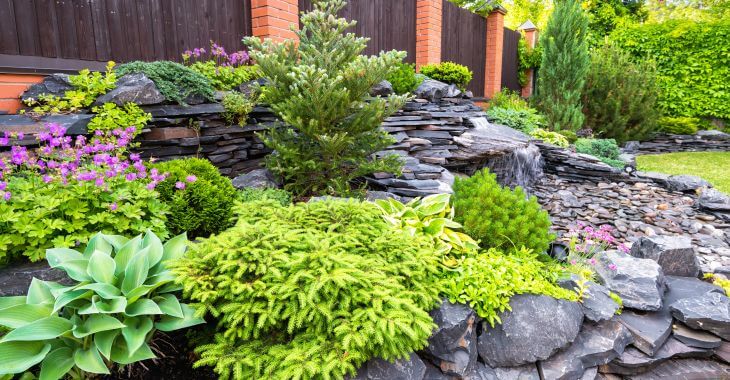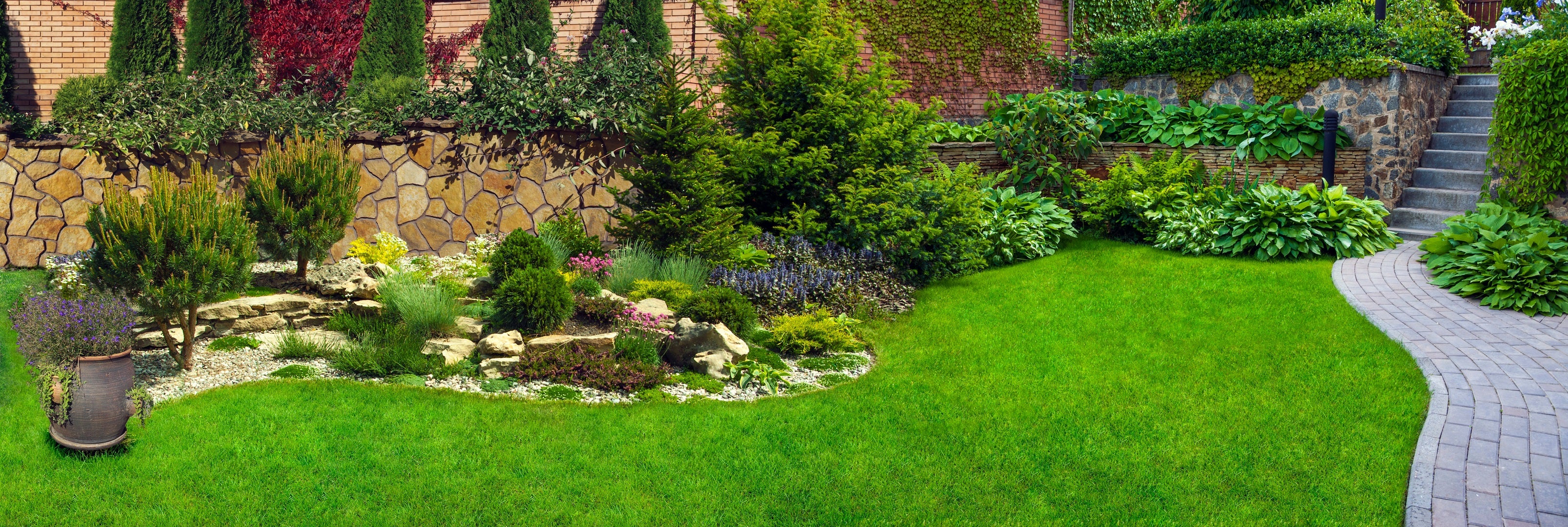Comprehend the Relevance of Sustainable Practices in Modern Landscape Design Providers
Sustainable techniques in modern-day landscaping are progressively recognized for their important function in environmental preservation. By implementing green strategies, landscaping specialists can boost biodiversity and reduce their eco-friendly footprint. This method not just elevates residential or commercial property looks however likewise promotes area health. As the demand for greener solutions expands, the question emerges: exactly how can these sustainable approaches improve the future of landscape design and our relationship with nature?
The Role of Lasting Landscape Design in Environmental Conservation
While several might neglect the significance of landscape design in environmental preservation, sustainable landscaping methods play a necessary duty in advertising eco-friendly equilibrium. By prioritizing native plants and lessening water use, these methods assist preserve neighborhood biodiversity and minimize the pressure on water sources. Furthermore, lasting landscaping can boost soil wellness via natural methods, which fosters an extra resilient ecosystem.Moreover, integrating permaculture principles boosts land efficiency while lessening ecological effect. This approach encourages using all-natural parasite control and reduces dependence on chemical fertilizers, consequently protecting surrounding environments. Landscaping that concentrates on sustainability likewise contributes to carbon sequestration, aiding to mitigate climate modification effects.Furthermore, green landscape design creates habitats for wildlife, promoting a diverse array of types. By participating in lasting practices, landscapers not just beautify rooms but additionally proactively join the larger effort to safeguard the environment for future generations.
Advantages of Eco-Friendly Practices for Landscape Design Professionals
Green practices in landscape design deal many advantages for specialists in the area - Landscaping St. Louis MO. These methods not just add to a decreased ecological impact however likewise enhance building value and cause long-lasting expense financial savings. By taking on lasting approaches, landscape design experts can produce a much more viable future for both their companies and the earth
Reduced Ecological Effect
As landscaping specialists progressively adopt environment-friendly practices, they contribute greatly to decreasing the ecological impact of their solutions. Carrying out lasting methods such as organic fertilizers, indigenous plant selection, and reliable watering systems reduces making use of damaging chemicals and saves water resources. These techniques not only boost dirt health however likewise support neighborhood biodiversity by creating environments for wild animals. By prioritizing making use of renewable energies and lowering waste, landscaping experts can substantially lower their carbon impact. In addition, integrating green innovations, such as solar-powered tools, additionally reduces dependence on fossil fuels. Overall, these eco-friendly techniques promote a much healthier environment, demonstrating the crucial role that sustainable landscaping plays in environmental stewardship.
Boosted Home Value
Buying lasting landscaping methods can considerably enhance property worth, with studies indicating that homes with properly designed eco-friendly areas can see a boost of as much as 15% in market price. Green landscapes not only bring in potential buyers but additionally produce an enduring impression that stresses a commitment to environmental stewardship. Functions such as native plants, water-efficient watering systems, and permeable paving add to visual appeal while reducing maintenance prices. Furthermore, properties with sustainable landscaping usually have lower water intake and energy expenses, contributing to their attractiveness. As awareness of climate adjustment and sustainability increases, purchasers increasingly focus on homes that show eco-conscious values, making sustainable landscape design a calculated investment for homeowner seeking to optimize their return.
Long-Term Expense Cost Savings
Lasting landscape design techniques provide considerable lasting expense financial savings for professionals in the market. By using native plants and drought-resistant landscaping, specialists can minimize water usage and lower watering costs. In addition, using organic fertilizers and parasite control techniques decreases chemical acquisitions and promotes much healthier soil, causing decreased maintenance costs with time. Carrying out efficient power resources, such as solar-powered lights, additionally lowers operational expenses. Lasting practices frequently lead to less repairs and substitutes due to the usage of long lasting products and designs that withstand ecological challenges. By spending in eco-friendly strategies, landscape design experts can not just improve their solution offerings but also enjoy ongoing cost savings that add to their general productivity and sustainability in a competitive market.

Water Conservation Methods in Landscaping
Reliable water preservation methods are crucial in landscaping, especially in areas encountering water scarcity. One prominent technique is the implementation of xeriscaping, which uses drought-resistant plants and lessens the requirement for extra watering. Furthermore, using drip watering systems can greatly reduce water waste by delivering moisture straight to the plant roots. Rainwater harvesting is one more efficient approach, permitting home owners to accumulate and store rain for landscape use. Dirt wetness sensors can better improve water efficiency by keeping an eye on soil conditions and educating irrigation timetables. Mulching is also helpful, as it helps keep dirt wetness while suppressing weeds. Landscape developers are encouraged to create contour yards that advertise natural water drainage and reduce overflow. By embracing these water preservation techniques, landscape design services can contribute to sustainable techniques while guaranteeing that greenery grows also in water-limited atmospheres.
Promoting Biodiversity Via Indigenous Plant Option
A varied variety of indigenous plants can substantially boost biodiversity in landscaping projects. By picking plants that are aboriginal to a specific area, landscaping companies can create atmospheres that cultivate a balance of ecological communities. Indigenous plants are adapted to neighborhood environment conditions and dirt types, requiring less water and upkeep compared to non-native species. This adaptation encourages the presence of indigenous wild animals, such as pollinators, birds, and valuable bugs, which depend on these plants for food and habitat.Furthermore, indigenous plants play a vital function in dirt health by minimizing disintegration and enhancing nutrient cycling. By promoting a range of types, landscapers can create resilient landscapes that are better furnished to withstand bugs and conditions. Subsequently, this strategy supports the general wellness of the environment, adding to sustainability. Emphasizing native plant more information selection not just enhances areas but also grows eco-friendly integrity, making it a significant aspect of contemporary landscaping techniques.
Waste Reduction Approaches in Landscape Maintenance
Applying waste reduction methods in landscape maintenance can significantly decrease ecological impact while optimizing resource efficiency. One reliable strategy entails composting organic waste produced during maintenance tasks, such as lawn trimmings and pruning debris. This technique not only diverts waste from garbage dumps however additionally improves soil health. In enhancement, utilizing compost effectively can minimize the requirement for chemical fertilizers and watering, therefore preserving resources.Another strategy is to adopt accuracy landscaping strategies, which concentrate on targeted applications of water and nutrients based upon specific plant requirements. This reduces unnecessary waste and improves plant health. Applying a regular maintenance routine can also decrease over-pruning and too much waste generation. Choosing durable products for landscape design projects warranties durability, ultimately lowering the frequency of replacements. Collectively, these techniques add to an extra sustainable method in landscape upkeep, promoting a much healthier community while lowering overall waste production.
The Visual Effect of Lasting Landscaping
While traditional landscape design typically prioritizes looks over environmental factors to consider, sustainable landscaping balances appeal with environmental duty (Landscaping St. Louis Missouri). This strategy embraces indigenous plants, which not just flourish in regional problems however additionally support local wild animals, enhancing the general aesthetic allure of a landscape. By making use of organic products and eco-friendly layout methods, sustainable landscaping creates vivid areas that show the natural environment.Furthermore, the consolidation of components such as rainfall yards and official website permeable paving not only boosts aesthetics but additionally adds to efficient water management. The usage of sustainable practices can cause one-of-a-kind and welcoming exterior rooms that urge biodiversity and cultivate a feeling of place.Ultimately, lasting landscape design goes beyond mere visual appeal; it cultivates a gratitude for nature while advertising ecological stewardship. This integration of elegance and sustainability not just improves the landscape however also influences a better connection in between individuals and their environment
Community Engagement and Education in Sustainable Practices
Sustainable landscape design not only boosts the visual allure of outside rooms but also acts as a platform for area interaction and education and learning. Through workshops and local initiatives, landscaping services can promote a much deeper understanding of lasting practices amongst neighborhood members. These programs frequently highlight the importance of indigenous plants, water conservation, and natural gardening techniques, allowing individuals to get hands-on experience.Moreover, area gardens play see an essential duty in advertising sustainability while supplying a shared space for interaction. Such initiatives urge collaboration and the exchange of concepts, developing a sense of ownership and responsibility among individuals. By integrating educational parts right into their solutions, landscaping experts can successfully bridge the void between environmental stewardship and community involvement. Ultimately, this involvement not just cultivates a much more educated public however likewise improves the collective dedication to lasting practices, making certain that these concepts are supported for future generations.
Frequently Asked Questions
What Are the Costs Connected With Carrying Out Lasting Landscaping Practices?
The expenses linked with applying sustainable landscaping techniques frequently consist of initial investments in environmentally friendly products, continuous maintenance expenses, and potential training for staff. However, long-lasting cost savings and ecological advantages can surpass these in advance expenses.

Just How Can Home Owners Get Going With Sustainable Landscape Design in the house?
House owners can begin lasting landscape design by assessing their lawn, picking indigenous plants, carrying out reliable watering systems, composting organic waste, minimizing chemical usage, and integrating compost to keep moisture, inevitably advertising an environmentally friendly outdoor atmosphere.
Exist Accreditations for Sustainable Landscape Design Specialists?
Various qualifications exist for sustainable landscaping experts, including the Association of Expert Landscape Designers' accreditation and the Sustainable Websites Campaign. These qualifications highlight ecological methods, advertising eco friendly landscaping strategies and boosting professional trustworthiness within the sector.
Exactly How Does Climate Modification Affect Landscape Design Practices?
Climate modification significantly impacts landscape design methods by altering plant growth patterns, increasing insect populaces, and requiring making use of drought-resistant flora. As a result, landscaping companies need to adapt their approaches to guarantee lasting and resistant outside settings.
What Plants Are Ideal for Low-Maintenance Sustainable Gardens?
The very best plants for low-maintenance lasting yards consist of indigenous species, succulents, and drought-resistant varieties. landscaping st louis. These plants need very little water, thrive in regional conditions, and support neighborhood environments, developing a resilient and eco-friendly garden